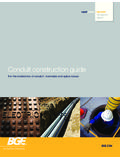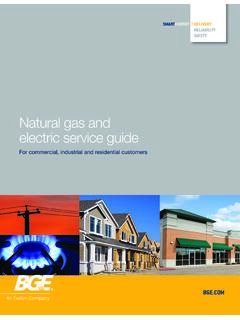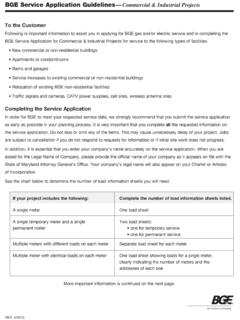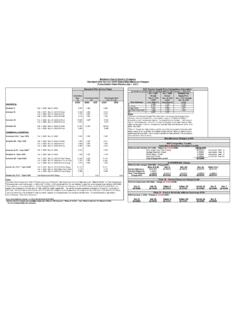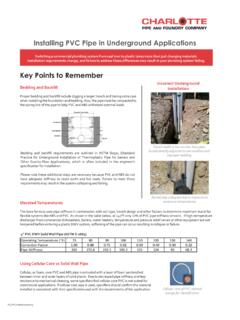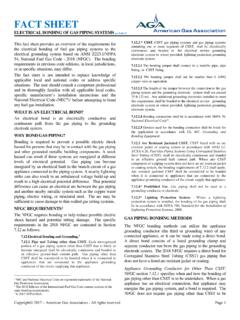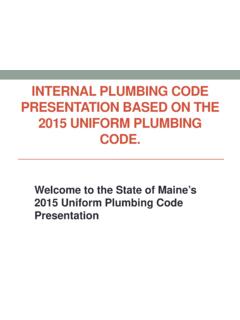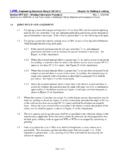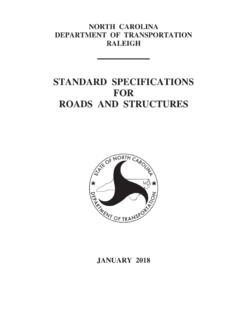Transcription of CONSTRUCTION GUIDE - Baltimore Gas and Electric
1 CONSTRUCTION guideFor the installation of conduit, manholes and splice boxesOne call to Miss Utility can savetime, money and you pick up any equipment, pick up the phone and call Miss Utility. Miss Utility will notify all applicable utility companies and see to it that your job site is marked for all underground utility lines. One simple phone call can save you the time and hassle of dealing with job site mistakes and delays. Not to mention decrease liability, prevent damage, reduce injuries and possibly save lives. After all, safety is everyone s Miss Utility, at least 48 hours prior to work, at 811 or Safely CHECKLIST1. Call Miss Utility at 811 or at least 48 hours prior to Allow the required time for utilities to mark the underground Respect and protect all Excavate with care. Take all reasonable actions to properly protect, support and backfill underground utility Immediately notify the utility if an underground utility line is If damage creates an emergency, take immediate steps to safeguard life, health and check with your individual jurisdictions with regard to waiting times and specific digging more information, contact Miss Utility or check online at you dig, every UTILITY 811 or s the information in this manual provides general guidelines for the installation of conduit, manholes and splice/pull boxes as it relates to BGE gas and Electric service.
2 These guidelines assist developers, general contractors, builders, architects, engineers, licensed electricians and plumbers in the engineering, planning and CONSTRUCTION of commercial, industrial and residential addendum provides clear and more consistent guidelines on the requirements for conduit and manhole CONSTRUCTION . This publication does not cover all the rules and regulations and is to be used in conjunction with the Commercial, Industrial and Residential Customer Information Booklet . For your convenience both booklets are available online at s goal is to work with you to install gas and Electric service promptly and safely while meeting all CONSTRUCTION codes and safety standards. Now and in the future, we re committed to providing safe and dependable natural gas and Electric hope the information in this manual answers your questions and guides you through the process. If there s anything we haven t made clear, please call us at OF CONTENTSGENERAL Guidelines.
3 2 Customer responsibilities .. 3 CONDUIT Specifications for Customer Installation .. 5 7 Standard Duct Bank Arrangement/Installation ..8 Plastic PVC Duct Spacers General Information ..9 Road Crossing Specifications .. 103-Phase Transformer Pad Dimensions Detail .. 111-Phase Transformer Pad Dimensions Detail .. 12 Turning Conduit Into Transformer Pads .. 13 SpLICE/pULL BOxESGeneral Information .. 15 Secondary (600V) Fiberglass Splice/Pull Box .. 16 Installation Instructions for 13 and 34 kV Boxes .. 17 Splice/Pull Box - 13kV (#2- 1/0 cables only) .. 18 Splice/Pull Box - 13kV (#2- 500 cables only).. 19 Splice/Pull Box - 2-sets 13kV or 1- set 34kV (#2- 750 cables) .. 20 21 MANHOLESG eneral Information .. 23 Installation of Precast Concrete Manholes .. 24 Small Secondary Manhole 1 to 4 Services.. 25 26 Large Secondary Manhole 1 to 7 Services .. 27 28 Precast Concrete Line Manholes.. 29 30 Precast Concrete Slotted End Wall Manhole.. 31 33 Installation Standards.
4 34 40 Materials Available from BGE Contractor Supplier ..41 DEFINITIONS AND FREqUENTLy ASkED qUESTIONSD efinitions ..44 Frequently Asked Questions .. 45 12345 NOTES11 GENERAL21 GUIDELInESGENERALBGE s underground Cable SystemsBGE s underground cable systems are divided into three types:1. Direct-Buried: (Cables/Gas Pipe installed directly in ground, not installed in any type of duct or sleeve)This type of system is typically used in rural or suburban areas where: Load density is relatively light; a concentration of cables does not exist. Circuits are not routinely added and front lot line installations. Dirt digging with occasional paving is expected. In these areas, the design principle used is loop feed primary and joint trenching with telephone and gas. Sleeving (short duct lengths) may be used in advance of paving where BGE utilities are to be installed at a later date ( road crossings, parking lots, etc.).2. Direct-Buried Conduit: (cables/gas pipe installed in PVC or flex polyethylene duct or sleeve that is installed directly in ground)This type of system is typically used in rural or suburban areas where special situations exist such as: Extensive paved areas with concrete or macadam such as parking lots.
5 Secondary distribution through paved, limited access, congested or potentially congested areas, thus preventing easy maintenance digging for repairs or replacement of the installed lines. Rocky soil conditions which could damage the cable.(note: Typically used in conjunction with splice/pull boxes and not concrete manholes.) 3. Concrete Encased Conduit: (Cables installed in concrete encased PVC duct)This type of system is typically used in urban areas where: Load density is significant. Concentration of circuits via the same route are planned or expected. Additional circuits will be added routinely. The concentration of circuits, limited Right-of-ways and an expected high number of circuits leaving distribution or master substations. Ducts are stacked on top each other.(note: Typically used in conjunction with concrete manholes and not splice/pull boxes.)(note: Gas sleeves will not be concrete encased.)31 GENERALG eneralThe information provided below is an addendum for conduit and manhole CONSTRUCTION only.
6 Please refer to the Commercial & Industrial and Residential Customer Information Booklet for the comprehensive list of rules, regulations and customer is responsible for engineering, designing, permitting, purchasing and constructing all required road crossings, ducts, conduit, splice/pull boxes and manholes according to the standards set forth in this document in order for BGE to provide gas and Electric s responsibility to perform the following:Pre- CONSTRUCTION Phase Submit BGE service application and obtain project number (WMS#). Provide loads and voltage class. Provide detailed utility site plans. Meet with BGE representative to discuss project scope, schedules and next steps. Develop detailed conduit and manhole drawings including profiles and duct runs. ** Submit conduit and manhole drawings to BGE for review. ** Submit drawings to local municipality and obtain required permitting. Sign and return required BGE design drawings and contract. Provide payment to BGE for project costs.
7 Contact inspector noted on BGE design drawings to schedule pre- CONSTRUCTION Phase Notify BGE immediately of any changes to schedule, scope or final design. Contact BGE to schedule Pre-pour Inspection. ** Contact BGE to schedule Pre-backfill Inspection. ** Contact BGE to schedule Mandreling and Stringing Inspection. **Post CONSTRUCTION Phase Satisfy all municipality inspections. Call BGE to schedule and release BGE project. ** When indicated on BGE : Not following specifications and standards in this booklet may cause delays in customer project and additional costs necessary for BGE to complete the rESPOnSIBILITIES42 CONDUIT52 CONDUITSPECIfICaTIOnS fOr CUSTOMEr InSTaLLaTIOnNote: Conduit from the meter termination point to the secondary side of the transformer is the standard method of installation for most three-phase commercial and industrial secondary services. The direct-buried method is still a method of installation where conduit installation would be impractical.
8 When required by BGE, the customer is responsible for designing and building ducts and conduit systems. Direct-Buried Electric ConduitPrimary and Secondary Electric Conduit1. Secondary conduit will be 4" minimum inside dimension Primary conduit size varies, contact BGE representative for actual BGE shall specify the number, size and configuration of All direct-buried ducts shall be UL schedule All bends shall be no less than 36" in radius. A total of two (2) 90 degree bends are allowed in the conduit line ( , conduit turn up at transformer pad is one (1) 90-degree bend). One (1) additional, wide-radius bend (minimum radius of five feet for this additional bend) will be allowed. If this still will not be sufficient for the conduit design/ CONSTRUCTION , contact your BGE representative. A hand hole, splice/pull box or manhole may be The customer shall pull a mandrel (1/2" smaller in diameter than the conduit and 6" long) through each duct prior to BGE cable installation, followed by a pulling line (1800 lb.)
9 Minimum tensile strength mule line preferred) which shall remain in each Customers will connect all Electric conduit with sealed/glue couplings and terminate their conduit with bell ends and Electrical ducts should be sloped away from the customer's building whenever possible to reduce the potential for water intrusion into the building as a result of failed or missing duct Required depth of conduit from final grade to top of conduit/conduit bank: 30" for secondary, minimum 36" for primary, minimum 48" maximum10. Backfill evenly around duct with clean dry earth and mechanically tamp in 12" Lengths of secondary duct banks shall be minimized to limit pulling distances and electrical losses. Any secondary duct lengths over 100 feet shall be approved by BGE prior to The minimum longitudinal separation between foreign structures and conduit should be as follows: Telephone/Cable Television Conduit 3" of concrete or 12" of earth Gas, Water, Sanitary and Oil Mains 12" of earth13.
10 Splice/pull boxes or manholes may be required by BGE depending on the specific If Electric service is being supplied from a new transformer, the customer's duct shall enter the transformer as shown on page titled "Turning Conduit into Transformer Pads" in section two (2) of this If Electric service is being supplied from an existing transformer, the customer shall end the secondary duct five feet from the secondary side of the transformer at a location determined by BGE. BGE will continue the duct into the transformer based on field fOr CUSTOMEr InSTaLLaTIOn (COnT'D)Direct-Buried Gas Sleeves1. PVC UL Schedule 40 conduit (solid wall, not split) may be used as a sleeve installed in advance of paving to facilitate future installation of small size (2" and smaller) gas services where casing is not required. The ends of the sleeve should not be sealed after insertion of the carrier pipe to avoid containment of gas in case of a gas leak. However, the end of the sleeve on a service line nearest the building should be sealed after installation of the carrier pipe and the opposite end of the sleeve left Gas services common trenched with Electric duct shall be in Gas sleeves shall not exceed one 45-degree bend, and must terminate a minimum of 5' from all buildings/structures.
